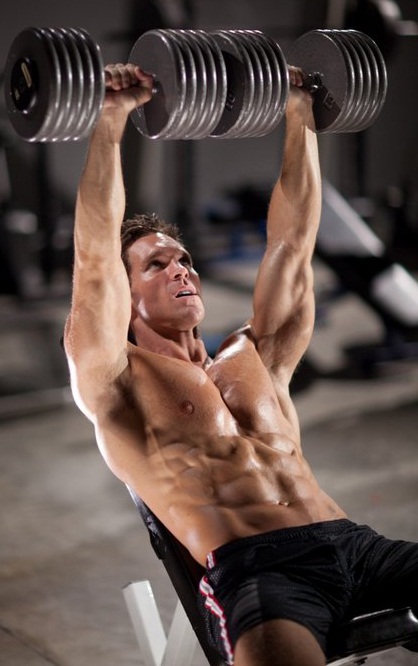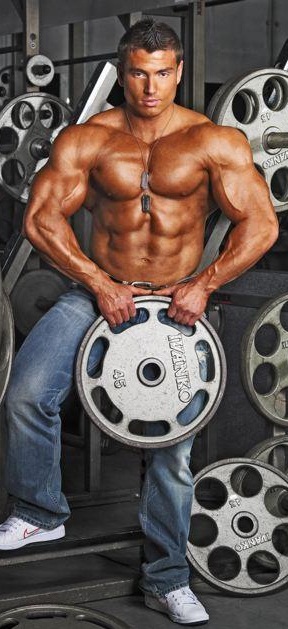[h=1]Pecs That Pop: 5 Training Experts Weigh In On The Best Methods For Building A Massive Chest[/h]
<section class="cb-entry-content clearfix" style="box-sizing: border-box; zoom: 1; margin: 0px 0px 30px; color: rgb(72, 72, 72); font-family: 'Open Sans', sans-serif; font-size: 14px; line-height: 25.2px;">

[h=2]Tip 2 Partial Reps[/h]
 “Doing partial reps at the end of a set will take your chest to a place it’s likely never been before total fatigue,” says Guillermo Escalante, MBA, ATC, CSCS, president of Sports Pros, a sports medicine, fitness and rehabilitation center in Claremont, California.
“Doing partial reps at the end of a set will take your chest to a place it’s likely never been before total fatigue,” says Guillermo Escalante, MBA, ATC, CSCS, president of Sports Pros, a sports medicine, fitness and rehabilitation center in Claremont, California.
What is it?
A partial rep is a rep that stops short of the typical range of motion for that exercise. If you gauge your fatigue by the inability to complete a full repetition, you aren’t taking the muscle to its true limit. If you continue with partial reps until you can no longer budge the weight, you know without doubt that you taxed the muscle to its upper limits.
[h=2]Do This:[/h]With a spotter close by, do three sets of incline barbell presses. When you can no longer do complete reps on the third set, continue repping in the lower one-half to three-fourths of the range of motion until you can no longer push the weight to the halfway point.
[h=2]Tip 3 Eccentric Training[/h]

[h=2]Do This:[/h]Do three sets of decline bench presses with a weight that limits you to 6-8 reps. On each rep of the third set, have a spotter push on the bar as you resist it down to your chest. Then your spotter lets go and you push the weight up with your newfound strength.
[h=2]Tip 4 Max Out First[/h]Another trick for gaining immediate strength and long-term muscle mass is to first max out on an exercise, then go for reps, states Tim Scheett, PhD, an exercise science professor at the University of Southern Mississippi (Hattiesburg). With this max-out technique, you’ll use a weight with which you can get only about 2-3 reps and do one rep with it, then follow with a lighter set for more reps.
[h=2]Tip 5 Explosive Reps[/h]“I like to combine standard exercises like the bench press with power moves that are explosive and ballistic,” remarks Neil Purves, MSc, CSCS, manager of Personal Training for Executive Fitness Leaders (Ottawa). Explosive moves, performed very fast with light weight, activate more fast-twitch muscle fibers, which have the highest potential for growth. “They also allow you to push the weight without having to slow it down, helping you to gain more power and strength,” he adds. For example, when you do a bench press, you push the weight off your chest as fast as possible, but you have to slow it down at the top due to the length limit of your arms. This steals your power and strength because you spend part of the lift actually pulling, not pushing.

[h=2]Do This:[/h]Set up a Smith machine with a weight that lets you get only about 6-8 reps. Do one set of normal bench presses with that weight. Immediately strip off about 50%-70% and do 3-5 ballistic bench press reps.
Start: For the plyometric portion, push the bar off your chest as fast as possible, letting it go at the top.
<section class="cb-entry-content clearfix" style="box-sizing: border-box; zoom: 1; margin: 0px 0px 30px; color: rgb(72, 72, 72); font-family: 'Open Sans', sans-serif; font-size: 14px; line-height: 25.2px;">

Close your eyes and picture this: You place your palms together in front of you, pressing them forcefully into each other. The contraction spreads up your forearms, through your biceps, triceps and shoulders, and explodes across your pectorals, rippling from outer to inner edge.
Your chest rises, clenching into a searing knot of muscle, popping your shirt buttons off, one by one. How would it feel to have pecs that big, brawny and powerful? Three words: Pretty damn good. As you probably realize, that kind of size isn’t built without a lot of effort. And even clockwork consistency in the gym won’t totally do the trick, as you can’t keep throwing the same battery of exercises, sets and reps at your body workout after workout and expect to achieve the superhuman results you seek.
To succeed, you need an array of solid training options at your disposal. So, to help, we’ve collected five hardcore techniques you can use to shake up your workouts from experts whose business it is to help people get huge and strong. Use these at your own risk sewing kit not included.
[h=2]Tip 1 Instability Tactics[/h]“One trick that works well to build the chest is called Stabilization Equivalent Training,” says Rodney Corn, MA, PES, CSCS, director of education for the National Academy of Sports Medicine. “For example, you follow a stable chest exercise like the dumbbell flye on a flat bench with an unstable equivalent move a dumbbell flye on an exercise ball with one leg bracing you.” Most guys steer clear of exercise-ball moves because they have to drop to a much lighter weight than they’re used to handling. But by doing so, you grow much stronger in the long run performing both stable and unstable moves. “Stability training places a greater demand on your body to internally stabilize itself,” Corn explains. “By training the brain how to work the pecs while stabilizing the body, you increase the potential of your pecs to produce more force.”
By doing the ball exercise immediately after the traditional version (with little to no rest between sets), the lighter weight now becomes more of a challenge for the chest because those muscle fibers are prefatigued.
[h=2]Do This:[/h]Do a set of flyes on a flat bench with dumbbells that allow you to get no more than 8-10 reps. After little to no rest, grab a pair of lighter weights and do 10-15 flyes on an exercise ball. Rest two minutes and repeat the superset twice more.
[h=2]Tip 2 Partial Reps[/h]

What is it?
A partial rep is a rep that stops short of the typical range of motion for that exercise. If you gauge your fatigue by the inability to complete a full repetition, you aren’t taking the muscle to its true limit. If you continue with partial reps until you can no longer budge the weight, you know without doubt that you taxed the muscle to its upper limits.
“For chest training, partial reps are perfect on press exercises like the bench press or machine press,” Escalante notes. “The reason is that the triceps play a monumental role in the top half of the exercise, Often you surrender on the bench press when your smaller triceps muscles fatigue, not the chest.”
By doing reps in the lower three-fourths of your full bench range of motion, you minimize the role of the triceps and maximize the use of the pectoral muscles ultimately leading to bigger pecs. Be careful when using this technique; it’s very taxing. Use it on only the last set of an exercise.
[h=2]Do This:[/h]With a spotter close by, do three sets of incline barbell presses. When you can no longer do complete reps on the third set, continue repping in the lower one-half to three-fourths of the range of motion until you can no longer push the weight to the halfway point.
[h=2]Tip 3 Eccentric Training[/h]

To get a bigger chest, you’ll need to develop stronger pecs. David Sandler, MS, CSCS, professor of exercise science at Florida International University (Miami), says one way to increase your strength on an exercise immediately is to overload the eccentric portion of the lift, in which you lower the weight.
“The heavier the weight that you’re lowering, the stronger you’ll be on the lifting phase of the exercise,” he adds. This is due to the potential energy that builds in a muscle as you stretch it. When you release the stretch as you begin to lift the weight, that energy is transferred to the contracting muscle fibers.
[h=2]Do This:[/h]Do three sets of decline bench presses with a weight that limits you to 6-8 reps. On each rep of the third set, have a spotter push on the bar as you resist it down to your chest. Then your spotter lets go and you push the weight up with your newfound strength.
[h=2]Tip 4 Max Out First[/h]Another trick for gaining immediate strength and long-term muscle mass is to first max out on an exercise, then go for reps, states Tim Scheett, PhD, an exercise science professor at the University of Southern Mississippi (Hattiesburg). With this max-out technique, you’ll use a weight with which you can get only about 2-3 reps and do one rep with it, then follow with a lighter set for more reps.
“Doing one rep on the bench press with an extremely heavy weight primes your nervous system to recruit the maximal amount of muscle fibers in your chest,” Scheett explains. “When you do a following set with lighter weight, the nervous system still recruits the same amount of muscle fibers as for the heavy weight in essence making the weight much easier so you can get several more reps.”
[h=2]Do This:[/h]Choose a weight with which you can bench press for only about two reps and do one set of one rep. Rest about three minutes and do a set with a weight that allows you to normally get 6-8 reps. You should be able to get 2-3 extra reps out of this second set. Repeat the process two more times.
[h=2]Tip 5 Explosive Reps[/h]“I like to combine standard exercises like the bench press with power moves that are explosive and ballistic,” remarks Neil Purves, MSc, CSCS, manager of Personal Training for Executive Fitness Leaders (Ottawa). Explosive moves, performed very fast with light weight, activate more fast-twitch muscle fibers, which have the highest potential for growth. “They also allow you to push the weight without having to slow it down, helping you to gain more power and strength,” he adds. For example, when you do a bench press, you push the weight off your chest as fast as possible, but you have to slow it down at the top due to the length limit of your arms. This steals your power and strength because you spend part of the lift actually pulling, not pushing.
With a ballistic bench press, you explode the weight off your chest and let it go: It’s all push and no pull.

[h=2]Do This:[/h]Set up a Smith machine with a weight that lets you get only about 6-8 reps. Do one set of normal bench presses with that weight. Immediately strip off about 50%-70% and do 3-5 ballistic bench press reps.
Start: For the plyometric portion, push the bar off your chest as fast as possible, letting it go at the top.
Finish: As you catch it on its descent, Immediately move into the next rep by bringing the bar to your chest and exploding back up. (Resist the motion of the bar on the descent only enough to stop it from crashing into your chest.) Rest two minutes; repeat the superset twice more.
</section>




